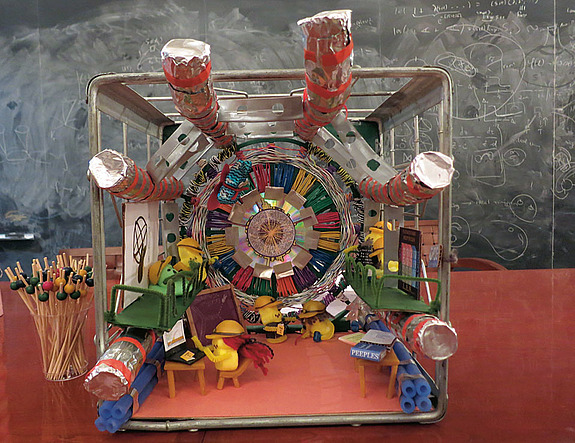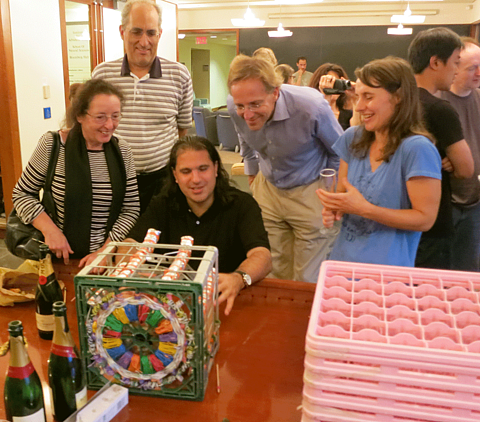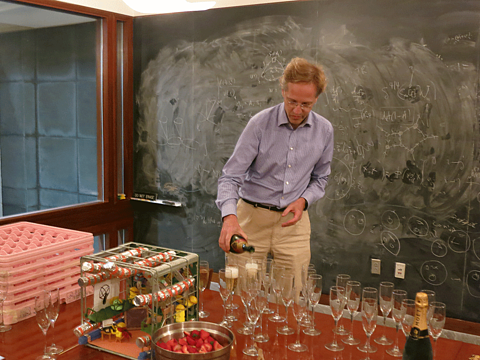Pre-Dawn Higgs Celebration at IAS

Before dawn on July 4, CERN scientists announced the discovery of a new particle consistent with the boson predicted nearly fifty years ago by Peter Higgs. He gave one of his first seminars on his theory at the Institute at the invitation of Professor Freeman Dyson, now Emeritus in the School of Natural Sciences. During his 1966 seminar, Higgs presented his theory of how most fundamental particles acquire mass as they interact with an energy field that exists everywhere in the universe. Soon after the CERN announcement, Dyson sent a message to Higgs through a colleague, David Derbes: “Please give my warm congratulations to Peter if you see him. What he did was beautiful and will outlast the temporary flood of hype.” Derbes met Higgs for dinner in Glasgow on July 24, and reported back to Dyson: “I think he was very appreciative.”
After nearly five decades of searching for confirmation of the existence of the Higgs particle that would result if Higgs’s theory is correct, Faculty and Members—along with Robbert Dijkgraaf on his fourth day as the ninth Director of the Institute—attended a pre-dawn celebration in Bloomberg Hall to witness the announcement by Rolf Heuer, Director-General of CERN. The news was momentous. Faculty and Members at the Institute have contributed many of the theoretical foundations of the Standard Model, which describes the fundamental building blocks of the universe, and its possible modifications. The discovery of a particle that looks much like the Higgs—the final element of the Standard Model that needs to be confirmed experimentally—promises to further understanding of the origin of mass and help clarify some long-standing mysteries.
On Wednesday, July 4, shortly after 4 a.m., the Institute’s new Director, Robbert Dijkgraaf, was in Bloomberg Hall, cracking open three bottles of vintage champagne to begin a rather unusual party. He was among the scientists who had been in the Hall’s lecture theater since 3 a.m. to watch a presentation from Geneva on the latest results from the CERN laboratory’s Large Hadron Collider. In the closing moments, after CERN’s Director-General Rolf Heuer cautiously claimed the discovery of a new sub-atomic particle—“I think we have it, yes?”—applause broke out in the CERN auditorium and in the Bloomberg Hall lecture theater. Within minutes, the IAS party was underway.
The new particle shows several signs that it is the Higgs boson, the only missing piece of the Standard Model, which gives an excellent account of nature’s electromagnetic, weak, and strong interactions. Although some physicists had come to doubt whether the boson existed, Nima Arkani-Hamed, Professor in the Institute’s School of Natural Sciences, was so confident that in 2007 he bet a year’s salary that it would be detected at the Large Hadron Collider. In the week before the CERN presentation, Arkani-Hamed invited colleagues to the party and organized the catering. Convinced that he had won his bet, he bought three bottles of champagne, including two of Special Cuvée Bollinger.
The Higgs boson has played a central role in fundamental physics since 1964, when several theoreticians—including Peter Higgs at the University of Edinburgh—suggested an explanation of why most fundamental particles have mass. According to the theory, these particles acquire their mass from their interactions with the Higgs field, invisible and elusive but permeating the entire universe. As with all quantum fields, there is a particle associated with the Higgs field—the Higgs boson, which has no electrical charge, no spin, and a mass that is unfortunately not possible to calculate. This uncertainty about the mass of the particle is one of the factors that made its detection so difficult.

By the early 1990s, a combination of robust theoretical arguments and the well-attested experimental results, notably from Stanford and CERN, persuaded many particle physicists that the Higgs boson exists. Yet, by 2007, some theoreticians started to get cold feet and a few even began to wonder if the Standard Model might be about to crumble. Arkani-Hamed was having none of this, which is why he made the bet. A member of the public took him up on it, after a fashion, wagering $100 plus an amount proportional to the mass of the Higgs, if it showed up. The amount was one dollar for each unit of the Higgs’s mass, as measured in the physicists’ preferred unit of GeV/c2, a tad less than the mass of the lightest hydrogen atom.
Experimenters at the Large Hadron Collider announced last December that they had found the first signs of a particle consistent with the Higgs boson, with about 125 GeV/c2. It remained to be seen whether the particle really did exist, or if the first hint had been a glitch in the data. A few months ago, when the CERN authorities announced that two of their experimental groups would announce their results jointly on July 4, the rumor mill began to grind noisily, especially on the Internet. A week earlier, it was common knowledge among physicists that something dramatic was afoot.
Arkani-Hamed expected between ten and fifteen colleagues to attend the screening of the presentation, but his prediction was not one of his most accurate—he was too low by a factor of three. The physicists watched mostly in silence as the experimenters’ story unfolded—the particle appeared to exist and to decay into others, such as pairs of photons, at the expected rates (though with one tantalizing exception). Unusually for a seminar like this, the IAS audience—as well as the one in CERN—broke into applause several times and there were even a few gasps of delight. The same was happening all over the world, now that the quest for the Higgs boson was apparently coming to fruition.
Arkani-Hamed later said that he “never doubted for a second” that the Higgs particle would be detected and that he would win his bet: “All decent theorists have known for some time that there had to be a Higgs boson more or less where it was found.” After a glass of champagne, he added: “Nature is extremely constrained—there aren’t nymphs around every tree and dryads around every corner. Physics works.”

The party was probably unique in the history of the Institute—no one could remember another occasion when its physicists quaffed champagne and speared Italian-style macerated strawberries after a seminar beginning in the middle of the night. Renée Hlozek, an astrophysicist at Princeton University, brought cookies decorated with a symbol denoting the Higgs field. On loan from Marilena LoVerde, a Member in the Institute’s School of Natural Sciences, and Laura Newburgh, a physicist at Princeton University, was a diorama of CERN’s huge ATLAS particle detector, delicately crafted from Peeps (marshmallow candies with hardened sugar shells), as well as paper and items molded from wax, held together with sticky tape.
A few hours after the party broke up, Robbert Dijkgraaf tweeted a photograph of the remnants of the celebration: “Decay products of 3 am #higgs event . . . Never forget 1st week as Director!” By then, Arkani-Hamed had talked with the New York Times’s science correspondent Dennis Overbye and given him the quote that concluded his report on the Higgs-like particle: “It’s a triumphant day for fundamental physics. Now some fun begins.”
Soon afterward, Arkani-Hamed heard that the gentleman who bet against Higgs agreed to pay him his winnings, $225. The check is, apparently, still in the mail.